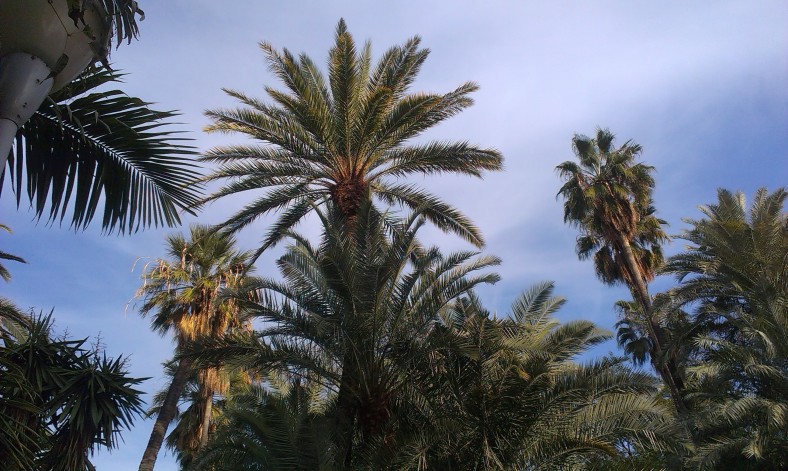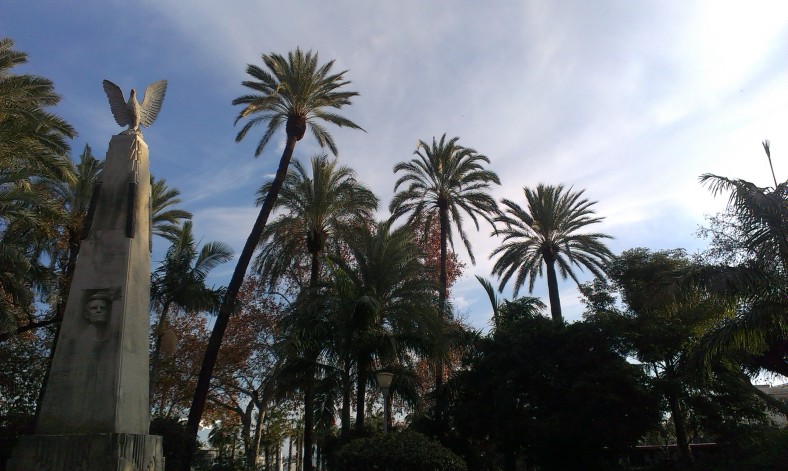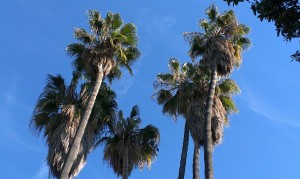We have seen that one of the factors which influenced the recent redevelopment of the Parque de Malaga was the poor condition of many of the older specimens; one cause of this being through the spread of the destructive Red Palm Weevil (Picado Rojo), Rhynchophorus ferrugineus Oliver.
The Picado Rojo is viewed as a most serious threat. It can affect a range of palm genera but principally has had an impact on the date palm Pheonix dactylifera and the Canary Island Palm Pheonix canariensis. The spread of the pest has come about almost exclusively through the importation of palms to southern Europe from the Middle East, mainly Egypt. The high demand in Spain and Portugal for ready-made mature palms for hotels and golf courses has discouraged home grown nursery production, in favour of imports in order to achieve the desired instant, landscaped effect.
The red palm weevil has advanced westwards since the mid 1980’s. There were sightings in Saudi Arabia in 1985, in Iran and Egypt (1992) finally reaching southern Spain in 1994, and the Portuguese Algarve at some point around this time. By 1999, there were reports of the pest in Israel, Palestine and Jordan. Initial controls on palms from Egypt failed to work – palms easily arrived in Spain from Egypt via other EU member states, and exporting nations have also been reluctant to destroy plantings due to the high economic cost it would incur.
The mature weevils are flying beetles, capable of travelling long distances from tree to tree, and able to climb trunks up to the crown. They are distinctly reddish in colour, with black markings, a beak prolongation and elbow-shaped antennae. The female weevils are able to lay about 200 eggs in the young palm leaves or soft tissue of terminal buds.
However, as gardeners familiar with our own common vine weevil in the UK are aware, the real damage to the tree is done by the larvae, and for a long time the effect remains unseen. These can grow up to 5cm in length, eating their way into the trunk of the tree, creating tunnels and cavaties up to a metre long in the soft, humid tissues. The pupae are later found outside at the base of the palm, protected by a coccoon of dried, brown palm fibres which emit an acidic scent. The effects of internal or root damage are therefore only viewed when it is too late – the palm showing delayed signs of ill health or even, in many cases, sudden collapse. In 2002, over 1000 Pheonix palms had been killed on the Spanish Mediterranean coasts of Malaga and Granada.
The problem in treating the pest is that its lifecycle “overlaps.” All forms – beetle, larvae, pupae – can be present in one tree at the same time, requiring expensive and (in public gardens) complicated forms of intergrated pest management (IPM), whether this be chemical spraying, injection, pheremone treatment or nematodes. The situation is further complicated by the rapid life cycle of the weevil of only three to four months, which ensures up to four generations of weevils every year. In addition to the Pheonix genera the other palms in the Parque thought to be under threat include Butia capitata, Roystonia regia, Trachycarpus fortunei and the Washingtonias, W. filifera, W.robusta.
Hopefully this is an interesting introduction for the reader to the topic of the Red Palm Weevil. It’s not the purpose of this blog to present a scientific paper on the subject ! However, I’ll post references, further reading and useful links in the Books, Websites, Contacts section as I find them.




